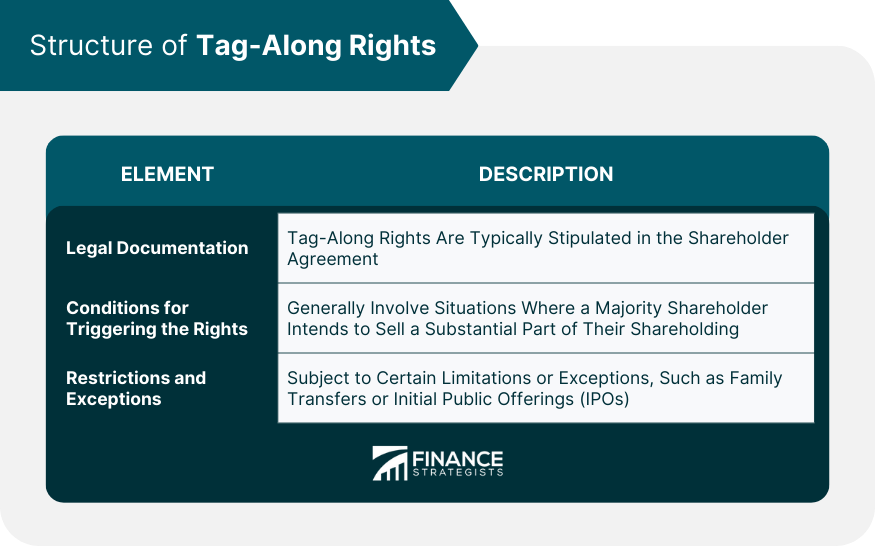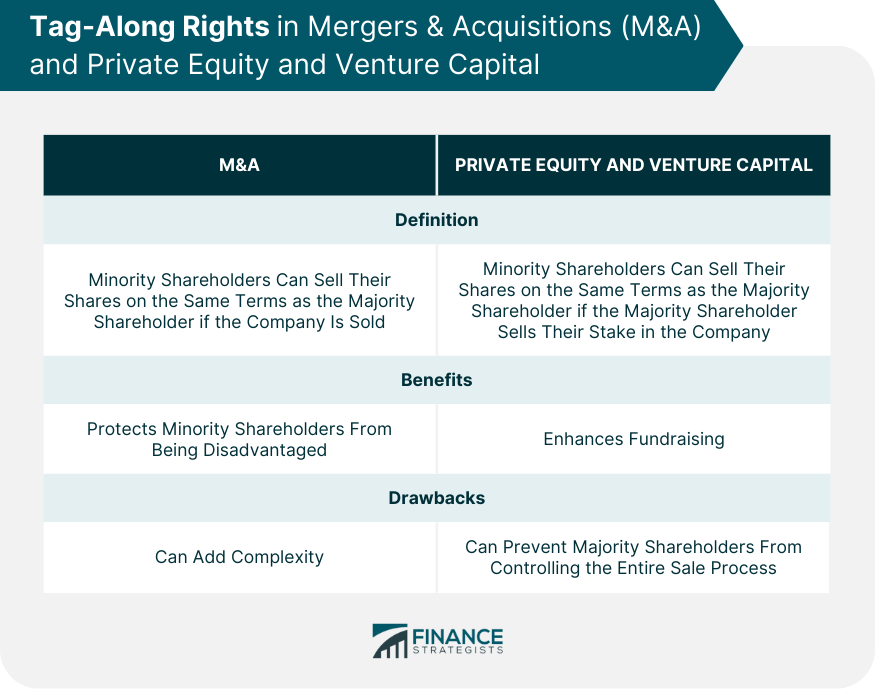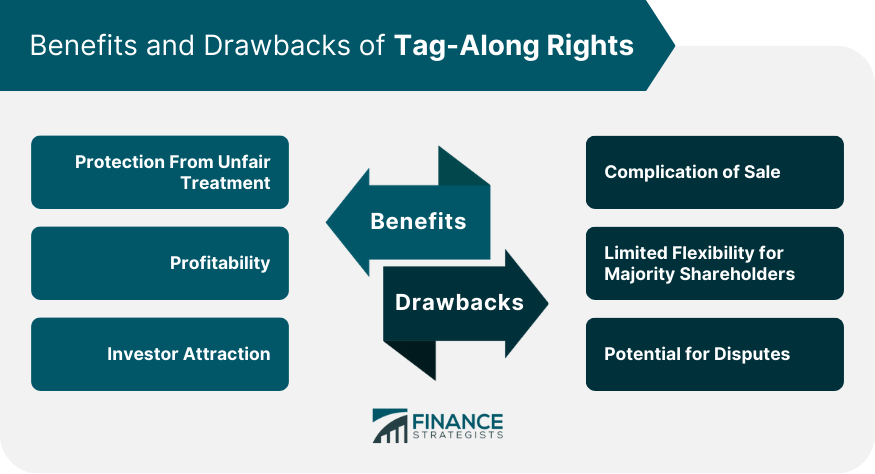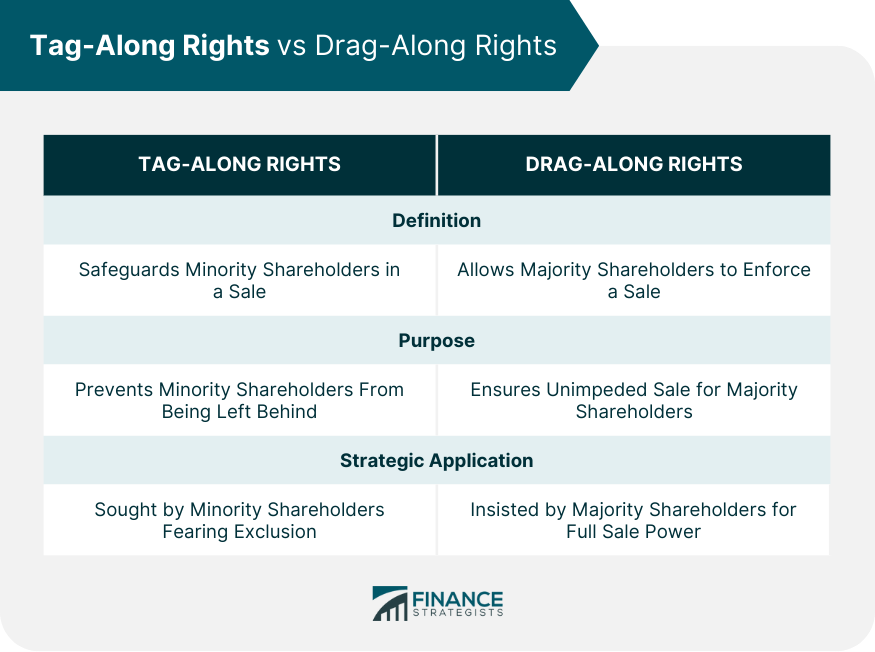Tag-along rights, or co-sale rights, safeguard minority shareholders by letting them participate in a company's sale, matching the terms of majority shareholders. If majority shareholders sell their stakes, minority shareholders can join the sale, ensuring financial benefits. These rights, usually stipulated in the shareholder agreement or articles of association, have a significant appeal for investors, particularly in venture capital and private equity deals, as they offer protection against disadvantageous positions if majority shareholders sell their stakes. The enforcement of these rights and specifics, such as the triggering percentage of sold shares and applicable share classes, vary considerably. Complexities may arise in cross-border transactions. Understanding tag-along rights is critical to protect your investment, particularly if you are a minority shareholder or plan to be one. Tag-along rights are typically stipulated and outlined within a key legal document known as the shareholder agreement. This agreement serves as the foundation for establishing tag-along rights, detailing the specifics of how and when these rights can be exercised, along with the prerequisites that must be fulfilled for their invocation. The conditions that serve to activate tag-along rights generally involve situations where a majority shareholder intends to sell a substantial part of their shareholding. However, the specifics of these conditions can vary greatly and are generally explicitly defined within the shareholder agreement. For example, the agreement may stipulate a percentage of shares that the majority shareholder needs to sell for the tag-along rights to effect. Tag-along rights are subject to certain limitations or exceptions, which largely depend on the specifics of the shareholder agreement. For instance, tag-along rights may not apply in certain scenarios, such as: Family Transfers: Majority shareholder transfers shares to a family member, which may be perceived as a personal matter rather than a corporate transaction. Initial Public Offering (IPO): Provisions in the shareholder agreement exclude tag-along rights when shares are sold as part of an IPO due to differing dynamics and regulations in public markets. Such restrictions and exceptions underscore the need for a thorough understanding and careful negotiation of the shareholder agreement terms to ensure that tag-along rights serve their intended protective purpose for minority shareholders. The recognition and regulation of tag-along rights can vary significantly between different jurisdictions. In some countries, these rights are well-recognized and enforced by law; in others, they may need to be better understood and regulated. The varying recognition of tag-along rights in cross-border transactions can lead to complexities. For instance, if a company with British and American shareholders is sold, the differing UK and US legal systems can complicate the enforcement of tag-along rights. Understanding the legal framework of all involved jurisdictions is crucial to ensure fair treatment of all shareholders. Regulatory changes can also impact tag-along rights. Changes in securities law, corporate law, or specific regulations on shareholder rights can all affect the application and enforcement of tag-along rights. Staying abreast of these changes is important for minority shareholders to protect their investments. In mergers and acquisitions (M&A), tag-along rights can provide important protections for minority shareholders. They ensure that if a company is acquired, minority shareholders have the right to sell their shares on the same terms as the majority shareholder. Tag-along rights can significantly influence the dynamics of M&A negotiations. They can add complexity to negotiations and influence the selling price of a company. Moreover, they can provide minority shareholders with more influence over the terms of a merger or acquisition. Tag-along rights in investment agreements protect minority shareholders. When a majority shareholder sells their stake, these rights ensure that minority shareholders can also sell their shares under the same terms. This prevents majority shareholders from negotiating deals that might disadvantage smaller investors, thus fostering fairness and confidence in investment partnerships. Tag-along rights enhance fundraising by making investments attractive to potential minority shareholders, ensuring their interests are protected. They also influence exit strategies by guaranteeing that minority shareholders can sell their shares under identical conditions as majority shareholders. This creates a balanced exit opportunity, preventing majority shareholders from controlling the entire sale process, promoting fairness, and mitigating potential conflicts during divestment. Tag-along rights ensure that minority shareholders have equal opportunities in the event of a company's sale. This provision protects them from potential inequitable practices by majority shareholders, thus fostering a sense of fairness and equal treatment in corporate governance. The advantages of tag-along rights for minority shareholders encompass several aspects: The most significant benefit of tag-along rights lies in its safeguarding nature against possible exploitation by majority shareholders. Should the majority shareholder decide to sell their stake, tag-along rights enable the minority shareholders to also participate in the sale under identical terms, ensuring equitable treatment. If a majority shareholder decides to sell their shares at a premium, minority shareholders can also benefit from this opportunity. This right ensures that minority shareholders can gain from the same lucrative exit that majority shareholders are offered. Tag-along rights can make a company more appealing to potential minority investors, who often seek assurance that their investment will be treated fairly in case of a sale. Tagged rights in a shareholder agreement can significantly boost investor confidence. While tag-along rights offer several advantages, they also come with certain drawbacks and potential issues: One potential disadvantage of tag-along rights is that they can make the sale of a company more complex and time-consuming. All shareholders, regardless of their stake in the company, must agree to the terms of the sale, which can prolong negotiations and potentially delay the entire sale process. Tag-along rights can limit the flexibility of majority shareholders. They may have to consider the interests and responses of minority shareholders, even if these investors hold a significantly smaller portion of the company. This can make the process of selling the company more cumbersome for the majority shareholders. Tag-along rights could lead to disputes among shareholders, especially if there are differing opinions about the terms of the sale. These disagreements can escalate into legal disputes, resulting in additional costs and delays. While tag-along rights protect minority shareholders, drag-along rights protect majority shareholders. Drag-along rights allow majority shareholders to force minority shareholders to participate in the sale of a company. This ensures that the majority shareholder can sell their entire stake without being held back by minority shareholders. The strategic application of tag-along and drag-along rights can vary greatly depending on the specific circumstances. For instance, in a scenario where a minority investor is concerned about being left behind in a sale, they may negotiate for tag-along rights. Conversely, a majority shareholder planning to eventually sell their stake might insist on drag-along rights to ensure they can compel all shareholders to sell when the time comes. Tag-along rights are an important protective measure for minority shareholders, ensuring they can participate equally in the sale of a company. They influence strategic decisions, M&A dynamics, fundraising efforts, and power balances among stakeholders. For investors, particularly those considering minority positions, insisting on tag-along rights can be a strategic move to protect their interests. On the other hand, companies, especially startups and those in the private equity or venture capital sectors, should consider the implications of these rights on their operations, potential for future sale, and overall attractiveness to investors. Looking forward, the landscape of tag-along rights may continue to evolve with the changing regulatory environment, cross-border investment dynamics, and the growing complexity of global business structures. Stakeholders should stay informed about these changes to navigate their potential impacts effectively.What Are Tag-Along Rights?
Structure of Tag-Along Rights
Legal Documentation
Conditions for Triggering the Rights
Restrictions and Exceptions

Tag-Along Rights in Different Jurisdictions
Variation in Legal Recognition and Regulation
Cross-Border Transactions
Regulatory Changes
Tag-Along Rights in Mergers and Acquisitions
Tag-Along Rights in Private Equity and Venture Capital

Benefits of Tag-Along Rights
Protection From Unfair Treatment
Profitability
Investor Attraction
Drawbacks of Tag-Along Rights
Complication of Sale
Limited Flexibility for Majority Shareholders
Potential for Disputes

Tag-Along Rights vs Drag-Along Rights
Comparison of Definitions and Purposes
Strategic Application in Different Scenarios

Conclusion
Tag-Along Rights FAQs
Tag-along rights, or co-sale rights, are provisions that allow minority shareholders to join in when majority shareholders sell their shares, typically at the same terms.
Tag-along rights protect minority shareholders by ensuring they get a fair deal if the company is sold. This can make investing in the company more attractive to potential minority investors.
While tag-along rights protect minority shareholders by allowing them to 'tag-along' in a sale initiated by majority shareholders, drag-along rights allow them to 'drag' minority shareholders into a sale, ensuring they can sell their entire stake.
Tag-along rights can influence the dynamics of M&A negotiations, add complexity to the process, and influence the final selling price of a company.
The application and enforcement of tag-along rights can be more complex in cross-border transactions due to the variation in legal recognition and regulation between different jurisdictions. Parties must understand the relevant legal frameworks to ensure fair treatment of all shareholders.
True Tamplin is a published author, public speaker, CEO of UpDigital, and founder of Finance Strategists.
True is a Certified Educator in Personal Finance (CEPF®), author of The Handy Financial Ratios Guide, a member of the Society for Advancing Business Editing and Writing, contributes to his financial education site, Finance Strategists, and has spoken to various financial communities such as the CFA Institute, as well as university students like his Alma mater, Biola University, where he received a bachelor of science in business and data analytics.
To learn more about True, visit his personal website or view his author profiles on Amazon, Nasdaq and Forbes.











